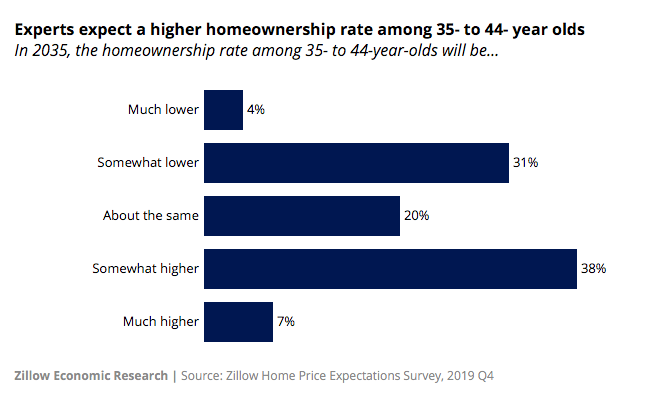Experts: More Gen Zers than Millennials Will Own Homes
By 2035, when Gen Z begins reaching age 40, experts said they largely expect the homeownership rate among 35- to-44-year-olds to be higher than it is today.

By 2035, when Gen Z begins reaching age 40, experts said they largely expect the homeownership rate among 35- to-44-year-olds to be higher than it is today.

In 2020, the oldest millennials will begin turning 40, capping a turbulent decade that presented any number of home buying difficulties for them at the same time as they aged into their prime home buying years and severely denting the homeownership rate among 35-to-44 year-olds. By 2035, when the younger Gen Z begins reaching the same age, experts said they largely expect conditions to be more favorable and for the homeownership rate among 35- to-44-year-olds to be higher than it is today.
The homeownership rate for 35- to 44-year-olds has fallen from 66% to 60% over the past decade, even as the overall homeownership rate has rebounded to 64.8% after bottoming out at 62.9% in 2016. Looking ahead 15 years, a plurality of more than 100 economists, analysts and real estate experts surveyed as part of the most recent Zillow Home Price Expectations Survey, sponsored by Zillow and administered by Pulsenomics, said they expected a higher homeownership rate among that age group.
Almost 4 in 10 experts with an opinion (38%) said they expected the homeownership rate among 35- to 44-year-olds to be somewhat higher in 2035, compared to 31% who said they expect it will be somewhat lower and 20% who said it will be about the same. Only a small share of experts said they expect a dramatic swing in either direction – 4% said the homeownership rate among this age group will be much lower 15 years from now, and 7% said it will be much higher.


There are many overlapping and complex factors that pushed homeownership among this key age group down over the past decade. These include rapid home price growth that outpaced income growth, intense competition from other buyers and a severe shortage of available homes to buy – especially lower-priced homes often sought by first-time buyers. High levels of student debt that made it more difficult to save for a down payment and a rise in rentership also played a role.
Experts tended to agree that the preference to own instead of rent and student loan burdens will be major factors in how the 35- to 44-year-old homeownership rate trends, but they disagreed on the direction they will move. Of those who said they expected the homeownership rate to increase, more people preferring to own instead of rent and the home supply being less constrained tied for the most cited reasons, closely followed by an expectation that student loan burdens will diminish. Those who predicted the homeownership rate will decrease most often cited the opposite – a smaller share of households will want to own their home, and student loan burdens will be greater.
Top Reasons Cited for Why 2035 Homeownership Among 35-44-year-olds will be HIGHER:
Top Reasons Cited for Why 2035 Homeownership Among 35-44-year-olds will be LOWER:
The panel of experts were also asked for their expectations for home value growth this year and through 2024. On average, panelists said they expect the median U.S. home to gain 3.6% in value in 2019, with annual growth slowing to 2.8% in 2020 and 2.3% in 2021, before rebounding to 2.6%, 2.9% and 3.4% from 2022-2024, respectively.
The experts’ individual predictions for U.S. home price growth in 2020 range from 7.4% growth to 3% contraction, and increased divergence in longer-run expectations confirms unsettled market conditions. The most optimistic group of experts expects 31.2% cumulative home value appreciation through 2024, while the most pessimistic expects a cumulative gain of just 7.8% over the same period. This spread in long-term expectations between panel optimists and pessimists is very near the highest level recorded in the ten-plus year history of this survey.